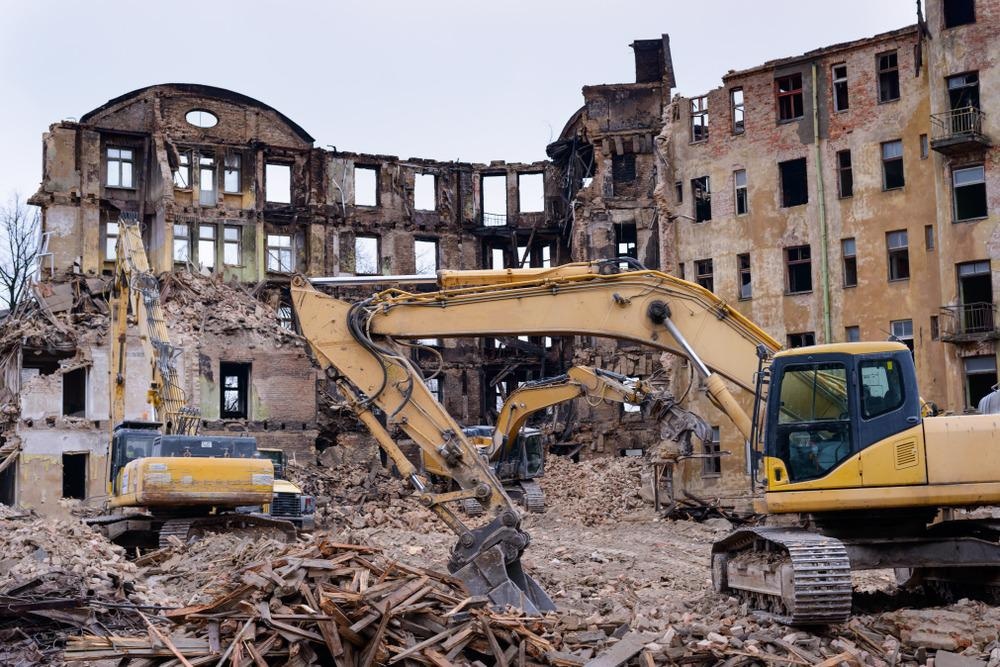There is a constant need for new building stock across the world. Changes in land use, population growth, and aesthetic needs all provide impetus to make changes to our built environment. Demolition is the preferred way to clear land for new developments, but the production of new building materials is very energy-intensive and emits a staggering amount of carbon dioxide.

Image Credit: microstock3D/Shutterstock.com
The Environmental Impact of Construction
The construction industry is incredibly polluting. In the UK alone, the built environment is responsible for approximately 40% of all emissions, along with 60% of the UK’s waste coming from excavation, construction, and demolition. Globally, the figure is similar.
According to the United Nations, the sector needs to halve its emissions by 2030 to be on track to achieve net zero by 2050.
Aside from polluting vehicles and machinery used in the construction industry, there is the issue with so-called “embodied” emissions. These are CO2 emissions that occur when construction materials and buildings are made.
Bricks and steel create huge amounts of carbon dioxide, and cement alone is responsible for 8% of global emissions. However, there is little public awareness of the issue compared to emissions from transportation, industry, and energy generation.
The construction industry must strive to become cleaner if global emissions targets are to be met by 2050. Even new builds of “energy efficient” homes and commercial spaces can take decades to offset the emissions generated in their construction.
Up to 51% of a residential building’s carbon is released before it is finished. Clearly, a new way of thinking is needed. The answer may be as simple as reusing buildings or parts of them rather than demolishing them and constructing new ones from scratch.
Out With the Old, in With the New?
There are plenty of examples of “throwaway” culture that are in the news today.
It seems that we have a love of new things whilst disregarding the benefits of what we already have. This is perfectly encapsulated in our attitude toward the built environment. Out with the old concrete and stone paradigm, in with the new steel and glass future.
The global demolitions industry clears vast amounts of housing stock that is no longer needed. In the UK alone, 50,000 buildings are demolished every year. Whilst a proportion of the buildings are cleared because they are dangerous and no longer useable, there are those that could still be refurbished and reused.
Demolition of buildings can also lead to a loss of cultural heritage. Take for example, the loss of Watson Fothergill’s Black Boy Hotel in Nottingham and its replacement with the current building with its squat, concrete form.

Image Credit: Aaron_Weiss/Shutterstock.com
Locally, it was seen as a travesty and the short-sighted planning decision of 1970s city officials still resonates today. Entire swathes of cities have been lost to history that could have been retained for future generations.
“Maximum reuse” is one of the UKGBC’s Circular Economy Guidance for Construction Clients five guiding principles. Some industry professionals are quick to point out that multiple barriers exist to reuse, justifying figures like the 50,000 buildings in the UK being demolished per year. There needs to be a vested interest in reuse rather than demolition if the industry is to meet its commitment to decarbonization.
Can Refurbishing Save Money?
Demolition is an expensive process. Certainly, demolishing a building and starting again will provide immediate benefits from the sale of the property, recouping the cost of construction. Refurbishing building stock rather than demolishing can provide financial benefits; however, this can be difficult to quantify for various reasons.
Money can be saved in materials, energy, labor, and other areas. Profit is calculated by end value minus build costs and purchase costs. If refurbishment saves costs on material, labor, and construction, profits will be higher.
The perception of a building’s environmental benefits can also inform its value: If reuse rather than replacing is seen as greener, buyers will be willing to pay more. Climate change is a hot topic for consumers (and there are people who value old buildings for taste and aesthetic reasons.)
Opportunities for the Creative Use of Space
Refurbishing old buildings allows for the creative use of space that would otherwise be lost. In the UK, Wetherspoons have long taken on cinemas, libraries, banks, and other historical buildings and repurposed them as pubs. They have worked with existing space to create something new that still pays homage to the unique history of the building.
Once a building is gone, any opportunity for creative use of its space has disappeared: Wetherspoons has shown there is another way.
Case Studies
There are examples of building projects that value reuse over replacement. A study assessing the cost/benefit ratio of demolition versus refurbishment of a 40-year-old detached house in Portugal was carried out.
The strategies were found to have almost the same building costs, so environmental impact was seen as a deciding factor. Energy and mass data were used to sustain the decision process in regard to intervention type.
Another case study has been carried out in Italy to assess the environmental impact of different intervention strategies using industrial units in Lecco slated for demolition.
A life cycle assessment (LCA) was adopted for five alternative construction methods. The study found that, compared to steel, concrete and timber were the best materials to use for refurbishment.
How Can the Shift to Refurbishment be Encouraged?
If we are to move away from demolition, the benefits of reusing buildings must be demonstrated to the construction industry and urban planners. In the UK, the Architects Journal has been campaigning against unnecessary demolition, but they are one piece of the puzzle.
Financial investors are increasingly demanding proof that their portfolios and assets have climate resilience, and occupiers are becoming more engaged and demanding.
It is up to governments to encourage the reuse and refurbishment of buildings as well. Currently, the UK government provides VAT incentives that encourage rebuilding by making the process cheaper. By shifting to incentives that encourage the reuse of properties instead, the financial benefits of refurbishing will reflect the societal and ecological benefits.
Further Reading and More Information
BBC.co.uk (website) Climate change: Construction companies told to stop knocking down buildings [Accessed online 14th October 2021] https://www.bbc.co.uk/news/science-environment-58667328
Pittau, F et al. (2019) Environmental consequences of refurbishment vs demolition and reconstruction: a comparative life cycle assessment of an Italian case study IOP Conf. Ser.: Earth Environ, Sci. 296 012037 [Accessed online 14th October 2021] https://iopscience.iop.org/article/10.1088/1755-1315/296/1/012037/meta
Gaspar, P.M & Santos, A.L (2015) Embodied energy on refurbishment vs demolition: A southern Europe case study Energy and Buildings 87(1) pp. 386-394 [Accessed online 14th October 2021] https://www.researchgate.net/publication/269679921_Embodied_energy_on_refurbishment_vs_demolition_A_southern_Europe_case_study
Will Hurst (2021) Demolishing 50,000 buildings a year is a national disgrace The Times [Accessed online 14th October 2021] https://www.thetimes.co.uk/article/demolishing-50-000-buildings-a-year-is-a-national-disgrace-wbrf09952
UKGBC (website) DEEP DIVE: The choice between demolition or reuse: developed insights [Accessed online 14th October 2021] https://ukgbc.org/news/the-choice-between-demolition-or-reuse-developer-insights/
Disclaimer: The views expressed here are those of the author expressed in their private capacity and do not necessarily represent the views of AZoM.com Limited T/A AZoNetwork the owner and operator of this website. This disclaimer forms part of the Terms and conditions of use of this website.